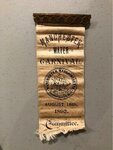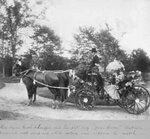





IN 1890, FEWER THAN 1,900 municipalities in the US had water supply systems, and of these, only 806 were owned publicly, with the rest operated by private companies with investors.
In Manchester, the committee charged with planning a water supply system presented a detailed argument for why the town would benefit from paying for and controlling its own system. Based on the committee’s report, a petition was submitted to the state legislature to allow Manchester to establish its own water works.
On March 20, 1891 Governor William E. Russell signed “An Act to Supply the town of Manchester with Water.” This statute gave Manchester permission to take water rights, obtain land for water supply, and incur debt to pay for the takings and the system; it also specified that three water commissioners must be elected, and town meeting must approve the undertaking by a two-thirds majority in order for the water works to go ahead.
On April 4, 1891 the town meeting accepted the law by a vote of 200 to 76. A series of bonds amounting to $125,000 were approved, and work proceeded.
The summit of Powder House Hill, then known as Cheever Hill, was selected for the standpipe by the Committee on Water Supply. The committee had met for the first time on July 22, 1890 and issued its report in early 1891.
Cheever Hill was close to both the center of town and the new source of well water, the four square miles of the Sawmill Brook watershed. The summit was also high enough: “four- and one-half feet higher than the underpinning of the house of Mr. J.C. Stevens, seven feet higher than Mr. Robinson’s, and 10 feet higher than Mr. Higginson’s,” according to the First Annual Report of the water commissioners in 1892. It was also “162 feet above the threshold of the Public Library building.”
Notably, the interests, elevations, and water use of the summer estates for their “external improvements and features of adornment” were repeatedly mentioned. In the 1892 Report, “By special arrangement, in accordance with a vote of the town, pipes were laid in many of the estates.” Including those larger properties that could afford the benefit of town water over private wells, in 1890 there were 417 houses in Manchester currently using private wells and cisterns of which 200 were expected to join the system.
Many more soon did so.
The function of the standpipe was to store enough water during fluctuations in demand and to provide constant pressure for all elevations. Reservoirs were larger and far preferable, but when no basin was available at elevation, standpipes or water towers were used.
The original standpipe on Powder House Hill was constructed of iron plates with steel rivets, which was more or less state-of-the-art in 1891 America. Cunningham Iron Works of Charlestown supplied the materials, with a low bid of $10,870.
“This structure, which is practically a reservoir, is 35 feet in diameter and 75 feet high and contains, when full to the estimated high-water mark, 518,000 gallons of water, weighing 2,154 tons,” the engineer wrote 1892. Each foot of water in the standpipe held 7,190 gallons.
The size of the standpipe proposed for Powder House Hill may have been unusual for its time. A typical municipal water tank or standpipe in the 1880’s might hold from 20,000 to 100,000 gallons, though some were as large as 500,000 gallons. For a small town such as Manchester, a 518,000-gallon tank was likely ambitious.
At the time, an iron standpipe only had an expected useful life of around 20 years, so, to prolong its life, the inside of Manchester’s standpipe was painted with tar (asphalt) to deter rust, a step that might be questionable today. In 1895 The Cricket reported that, “Four men have been enjoying camp life living in a tent atop Powder House Hill this week. They are painters who came from Lynn and are engaged in painting the inside of the standpipe.”
“In the [eighteen] eighties, the standpipe was … inexpensive, profitable to iron works contractors in the expanding iron and steel industry, and assumed to be simple to design and erect. Its basic form was a product of the industrial era, with no architectural pretensions. Standpipes in the nineteenth century were fabricated of wrought or cast iron or steel plates of varying thicknesses… set on an even stone or concrete foundation,” according to a 1980 master’s thesis, The Architecture and Engineering of Elevated Water Storage Structures. “The economics of standpipes were their greatest selling point, particularly for communities constructing their first water works system.”
In the old photos of the standpipe high over the town, it resembles a conspicuous monument to the growth of Manchester. “Because public water service was a benefit of civilization shared by community members, these structures reflected the goals of the community: symbolized in the storage of water was the collective energy of the community and its aspirations for continuity and regeneration,” the thesis continues.
In his Engineer’s Report appended to the 1892 Annual Report, Mr. Percy M. Blake of Hyde Park, Boston, the engineer hired to design the new water works, wrote of Manchester’s new standpipe and foundation that, “the foundation on which the standpipe rests was constructed by the town, and there can be no doubt as to its permanence and the solidity of its site.”
This was of consequence; early standpipes were known to fail. If Manchester’s did, a tremendous amount of water would cascade down onto houses near School Street.
On February 22, 1892 the standpipe was filled with water for the first time and was found to be essentially watertight. The initial work of planning, building, and paying for an entirely new and modern water supply system had finished. The town had located a good source of water, built storage at elevation, dug up streets to lay pipes, purchased pumps, hired new employees, issued bonds, set rates, settled land takings, and more.
Then, on August 18, 1892, a celebration. The Manchester Water Carnival (Celebration) was held to mark this tremendous achievement. Carriages and floats decorated in flowers and bunting lined the streets in a massive parade, bands played music, food was served in abundance, and during the evening a procession of boats and yachts entered the harbor lit up with lanterns. Agnes Booth, an acclaimed theater actress and proprietress of the Masconomo Hotel overlooking Singing Beach, was among the carriage procession.
In 1909 the standpipe on Powder House Hill was taken offline, replaced by a larger reinforced concrete standpipe on Moses Hill. The elevation there was higher than Powder House Hill, and the tank was built of a more durable modern material, concrete reinforced by steel, with a capacity nearly twice as large (1,022,000 gallons).
Moses Hill was also closer to Gravelly Pond, one of two sources of water for Manchester. The swelling of the summer population, and uncertainty over the volume of water that could be withdrawn from the groundwater in the Sawmill Brook watershed, meant the early water commissioners were already looking to Gravelly Pond, even as they determined that an underground source was superior to surface water.
The Powder House Hill standpipe remained empty on its foundation until 1919. That year, a contract was awarded to the Perry, Duxton Doane Co. of Chelsea to remove the rusted iron for $1,066, and the next year, “Four carloads of material from the old standpipe on Powder House Hill were shipped to New York.”
For 64 years until 1984 the platform lay empty.
The buried foundation on Powder House Hill today is more than a relic of outdated infrastructure. It is the visible legacy of a period in Manchester history—and the nation’s history—when drinking water became an affordable commodity for almost everyone. Population growth, industrial technology, and the need to effectively protect property from fire meant private wells and cisterns supplemented by small reservoirs were no longer sufficient.
In Manchester, the original standpipe, well house, and pumping station are gone. Only a few of the old pipes linger underground, so this foundation is significant.
Unlike the iron pipes rotting in the ground, it is also beautiful.